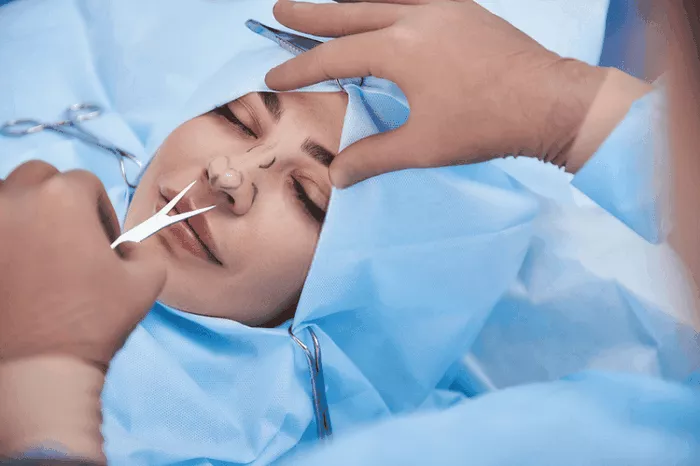Rhinoplasty, also known as nose surgery, is a cosmetic procedure that is designed to improve the appearance of the nose. After the procedure, patients are often advised to wear rhinoplasty gel to help reduce swelling and promote healing. In this article, we will explore how long you should wear rhinoplasty gel, what it does, and how it can benefit you during the recovery process.
What is Rhinoplasty Gel?
Rhinoplasty gel is a topical cream that is applied to the nose after surgery. It is designed to help reduce swelling and bruising, as well as promote healing. The gel is usually made from a combination of natural and synthetic ingredients, including arnica, vitamin K, and aloe vera.
How Does Rhinoplasty Gel Work?
Rhinoplasty gel works by reducing inflammation and improving circulation to the nose. The natural ingredients in the gel, such as arnica and aloe vera, have anti-inflammatory properties that help to reduce swelling and bruising. Vitamin K helps to improve circulation, which can also help to reduce swelling and promote healing.
In addition to these benefits, rhinoplasty gel can also help to moisturize the skin and prevent dryness and flakiness. This can be especially beneficial during the early stages of recovery, when the skin may be more sensitive and prone to dryness.
How Long Should You Wear Rhinoplasty Gel?
The length of time that you should wear rhinoplasty gel will depend on your individual recovery process. In general, most patients are advised to wear the gel for the first two weeks after surgery. During this time, the gel can help to reduce swelling and bruising, as well as promote healing.
After the first two weeks, your surgeon may recommend that you continue to use the gel for an additional week or two, depending on your individual recovery process. It is important to follow your surgeon’s instructions carefully and to continue using the gel as directed to ensure the best possible outcome.
How to Apply Rhinoplasty Gel
When applying rhinoplasty gel, it is important to follow the instructions carefully to ensure that you are using the product correctly. Here are some general guidelines for applying rhinoplasty gel:
Cleanse the nose: Before applying the gel, it is important to cleanse the nose thoroughly to remove any dirt or debris. Use a gentle cleanser and pat the nose dry with a clean towel.
Apply a small amount of gel: Use a small amount of gel and apply it to the nose in a thin layer. Be sure to cover the entire nose, including the tip and the sides.
Massage the gel in: Gently massage the gel into the skin using circular motions. This will help to improve circulation and promote absorption.
Repeat as needed: You may need to apply the gel several times a day, depending on your individual recovery process. Follow your surgeon’s instructions carefully and apply the gel as directed.
Benefits of Using Rhinoplasty Gel
There are several benefits to using rhinoplasty gel during the recovery process. These include:
Reduced swelling and bruising: Rhinoplasty gel can help to reduce swelling and bruising, which can be especially beneficial during the early stages of recovery.
Improved circulation: The vitamin K in rhinoplasty gel can help to improve circulation, which can also help to reduce swelling and promote healing.
Moisturized skin: Rhinoplasty gel can help to moisturize the skin and prevent dryness and flakiness, which can be especially important during the early stages of recovery.
Improved comfort: Using rhinoplasty gel can help to improve overall comfort during the recovery process, as it can help to reduce pain and discomfort.
Tips for Using Rhinoplasty Gel
Here are some additional tips for using rhinoplasty gel during the recovery process:
Follow your surgeon’s instructions carefully: Your surgeon will provide you with specific instructions on how to use the gel. Be sure to follow these instructions carefully to ensure the best possible outcome.
Be consistent: It is important to use the gel consistently during the recovery process. This will help to ensure that you are getting the full benefits of the product.
Don’t overdo it: While it may be tempting to apply more gel than recommended, it is important to use the product as directed. Applying too much gel can actually slow down the healing process.
Be patient: It can take time to see the full benefits of rhinoplasty gel. Be patient and continue to use the product as directed for the best possible outcome.
Potential Risks and Complications
While rhinoplasty gel is generally safe and well-tolerated, there are some potential risks and complications to be aware of. These may include:
Allergic reactions: Some patients may be allergic to the ingredients in rhinoplasty gel. If you experience any signs of an allergic reaction, such as itching, redness, or swelling, stop using the product and contact your surgeon.
Irritation: Some patients may experience skin irritation or redness after using rhinoplasty gel. This is usually temporary and will resolve on its own.
Infection: While rare, there is a risk of infection after using rhinoplasty gel. Be sure to follow your surgeon’s instructions carefully and keep the area clean to minimize this risk.
Conclusion
In conclusion, rhinoplasty gel can be a beneficial tool during the recovery process after nose surgery. It can help to reduce swelling and bruising, improve circulation, moisturize the skin, and improve overall comfort. The length of time that you should wear rhinoplasty gel will depend on your individual recovery process, but most patients are advised to wear the gel for the first two weeks after surgery. If you are considering rhinoplasty, be sure to talk to your surgeon about the benefits of using rhinoplasty gel and how it can benefit you during the recovery process.

